Sparse Autoencoders for a More Interpretable RLHF
Extending Anthropic's recent monosemanticity results toward a new, more interpretable way to fine-tune.
Introduction
Understanding how machine learning models arrive at the answers they do, known as machine learning interpretability, is becoming increasingly important as models are deployed more widely and in high-stakes scenarios. Without interpretability, models may exhibit bias, toxicity, hallucinations, dishonesty, or malice, without their users or their creators knowing. But machine learning models are notoriously difficult to interpret. Adding to the challenge, the most widely used method for aligning language models with human preferences, RLHF (Reinforcement Learning from Human Feedback), impacts model cognition in ways that researchers do not understand. In this work, inspired by recent advances in sparse autoencoders from Anthropic, we investigate how sparse autoencoders can help to interpret large language models. We contribute a novel, more interpretable form of fine-tuning that only learns parameters related to interpretable features of the sparse autoencoder.
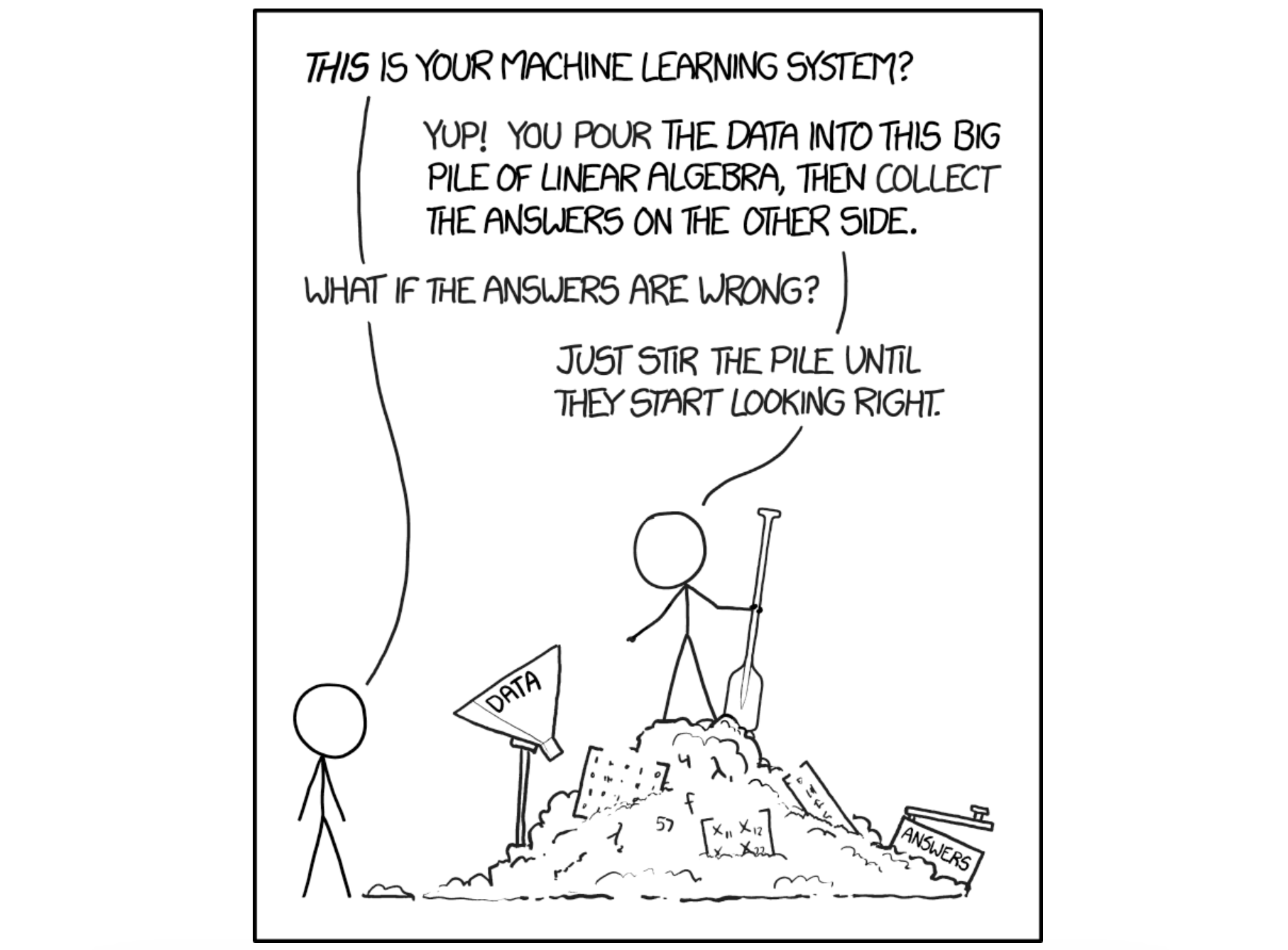
Related Work
Research on interpreting machine learning models falls broadly under one of two areas: representation-based interpretability (top-down) and mechanistic interpretability (bottom-up).
Representation-based interpretability seeks to map out meaningful directions in the representation space of models. For example, Li et al.
Mechanistic interpretability, unlike representation engineering, studies individual neurons, layers, and circuits, seeking to map out model reasoning at a granular level. One challenge is that individual neurons often fire in response to many unrelated features, a phenomenon known as polysemanticity. For example, Olah et al.
Recently, Sharkey et al.
Researchers have begun to apply sparse autoencoders to other interpretability problems. For example, Marks et al.
Background
An autoencoder is an architecture for reproducing input data, with a dimensionality bottleneck. Let $d_\text{model}$ denote the dimension of the residual stream in a transformer (4096 for Pythia 6.9B). Let $d_\text{auto}$ denote the dimensionality of the autoencoder. To enforce the dimensionality bottleneck, we require $d_\text{model} > d_\text{auto}$. The diagram below depicts an autoencoder.

A sparse autoencoder relies on a different kind of bottleneck, called sparsity. For a sparse autoencoder $g \circ f$ that acts on $x \in \mathbb{R}^{d_\text{model}}$ by sending $f(x) \in \mathbb{R}^{d_\text{auto}}$ and $g(f(x)) \in \mathbb{R}^{d_\text{model}}$, the training objective combines MSE loss with an $L^1$ sparsity penalty:
\[\mathcal{L}(x; f, g) = \|x - g(f(x))\|_2^2 + \beta \| f(x) \|_1,\]where $\beta > 0$ trades off sparsity loss with reconstruction loss. With the sparsity constraint, we can now let $d_\text{auto} > d_\text{model}$ by a factor known as the expansion factor. In our work, we typically use an expansion factor of $4$ or $8$. The purpose of the sparse autoencoder is to expand out the dimension enough to overcome superposition. The diagram below depicts a sparse autoencoder.
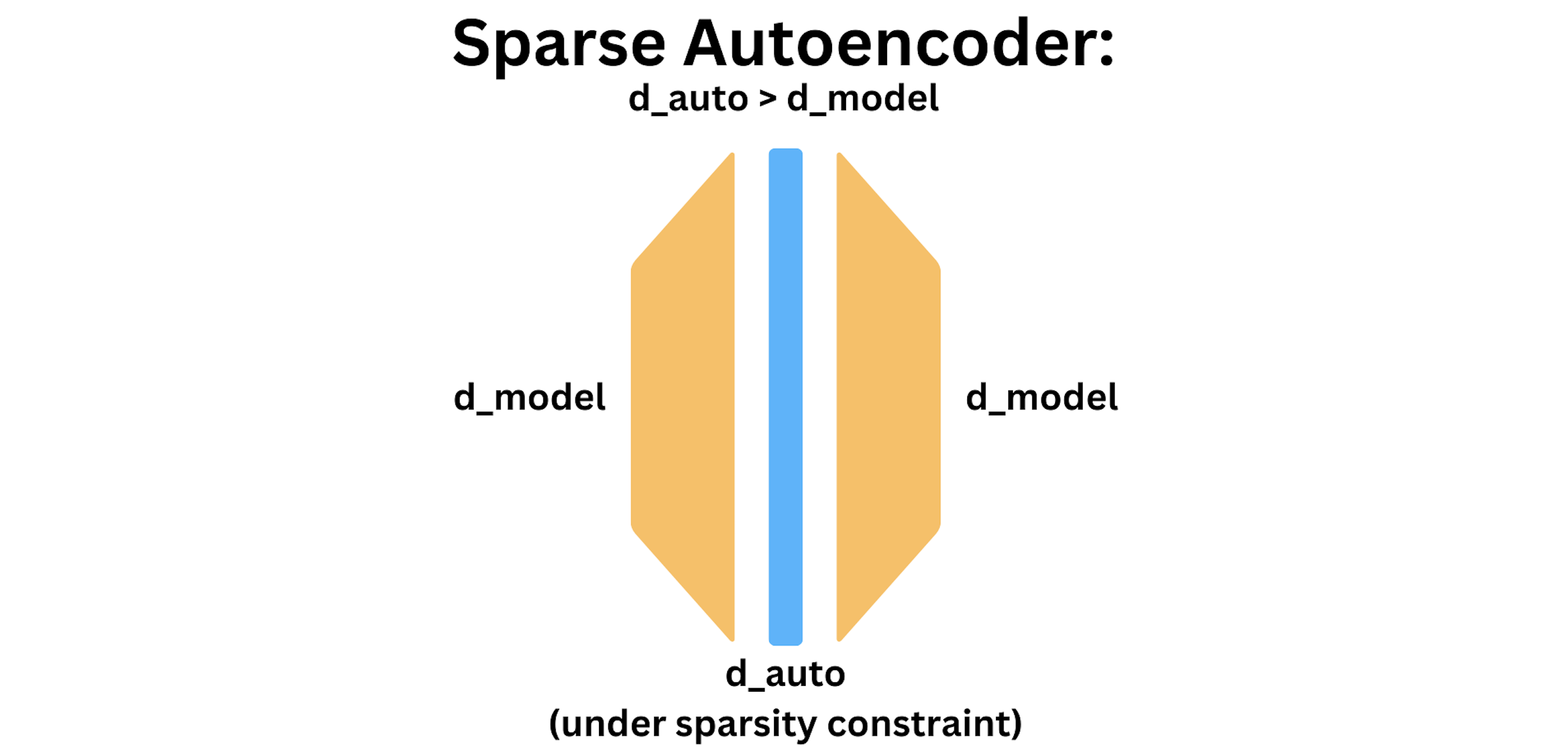
Methods
Our main experiment is to insert a sparse autoencoder into a transformer layer, train the sparse autoencoder, and then use the fused model to perform a new, more interpretable form of fine-tuning.
Inserting a Sparse Autoencoder in a Transformer
There are three natural places to insert a sparse autoencoder into a transformer:
- MLP activations before the nonlinearity
- MLP activations before adding back to the residual stream
- The residual stream directly
We choose the second option. The upside of operating in the MLP space is that MLP blocks may be in less superposition than the residual stream, given that MLPs may perform more isolated operations on residual stream subspaces. The upside of operating after the MLP projects down to the residual stream dimension is a matter of economy: because $d_\text{model} < d_\text{MLP}$, we can afford a larger expansion factor with the same memory resources.
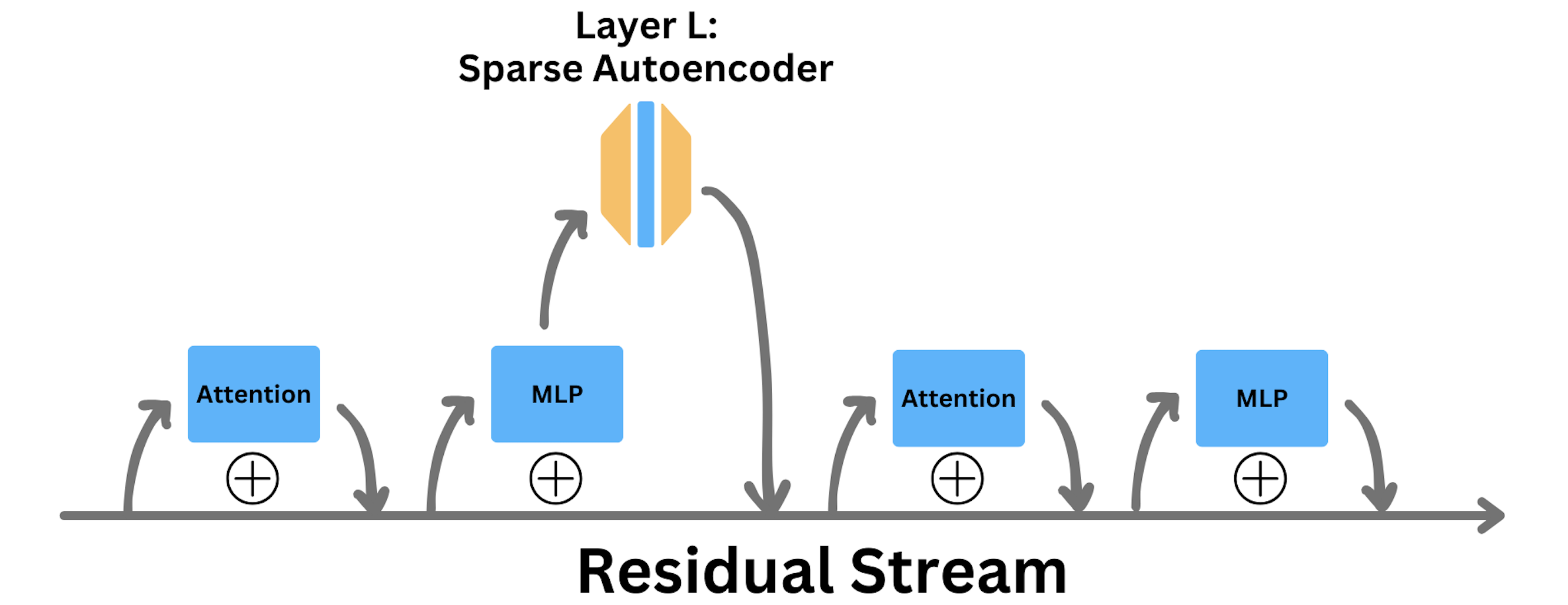
How We Train our Sparse Autoencoder
We train our sparse autoencoder to reproduce MLP-post activations in layer one of Pythia 6.9B (deduplicated)
Concretely, our sparse autoencoder has four learnable parameters: $W_\text{enc}$, $W_\text{dec}$, $b_\text{enc}$, and $b_\text{dec}$. The second bias $b_\text{dec}$ is used to center the input. The sparse autoencoder encodes, applies a nonlinearity, and decodes its input $x$ as follows:
\[\text{SAE}(x) = \text{ReLU}((x - b_\text{dec}) W_\text{enc} + b_\text{enc}) W_\text{dec} + b_\text{dec}.\]We constrain the rows of $W_\text{dec}$ to have unit norm by renormalizing after each optimizer step. Another approach to constrain the rows is to remove gradient information parallel to the feature vectors before each optimizer step, and also renormalize the rows. Although we did not implement it, Anthropic found that that the second approach slightly reduces loss
We use an expansion factor of $4$, meaning $d_\text{auto} = 16384$. When training, we use batch size $8$, learning rate $10^{-4}$, and default $\beta_1 = 0.9, \beta_2 = 0.999$ for the Adam optimizer. Because Pythia 6.9B’s context length is $128$ tokens, each training step includes activations from $1024$ tokens. We save checkpoints every $20000$ steps ($20.48$ million tokens).
One subtlety in training is that the sparsity constraint can eventually cause some autoencoder neurons to never activate. How to best handle these so-called dead neurons is an open question. We follow Anthropic in resampling dead neurons to new values
Fine-Tuning
We fine-tune Pythia 70M
For our fine-tuning experiments, the sparse autoencoder we use is trained on Pythia 70M Chess (a variant fine-tuned on a chess dataset)
We train with batch size $8$, learning rate $10^{-3}$, and weight decay $10^{-2}$ using the AdamW optimizer
Results
Our results come in two parts: an exploration of our trained sparse autoencoder on Pythia 6.9B and an analysis of fine-tuning using a smaller sparse autoencoder on Pythia 70M.
Exploring a Sparse Autoencoder
When inserted into Pythia 6.9B at layer one, our sparse autoencoder achieves a loss of $3.201$ (zero-ablation degrades loss to $3.227$) on the held-out dataset WikiText-103, consisting of over 100M tokens from Good and Featured articles on Wikipedia. Pythia 6.9B’s baseline loss is $3.193$. Notably, the sparse autoencoder outperforms a zero-ablation of the layer, demonstrating that it learned features that are useful for reconstruction.
As expected, if the sparse autoencoder is inserted into a layer it was not trained for, performance collapses. For example, if inserted at layer $31$ of Pythia 6.9B, the loss becomes $12.586$. Below is a figure showing the additional loss from inserting the sparse autoencoder at the first eight layers of Pythia 6.9B.

For more details on the training run, four figures demonstrating the sparsity, $L^1$ coefficient, $L^1$ loss, and reconstruction loss of our sparse autoencoder during training are shown below. After training on the first five million tokens, we automatically begin to adjust the $L^1$ coefficient $\beta$ until we reach the desired sparsity of $1\%$. By the end, our sparse autoencoder stabilizes at a sparsity of $100$, which means that only $0.5\%$ of sparse autoencoder features activate on a given token.




We find that our sparse autoencoder learned several interpretable features. For example, the second most frequently activating feature (feature index $11928$) activates strongly on the token “·the”. The figure below shows a table with examples.
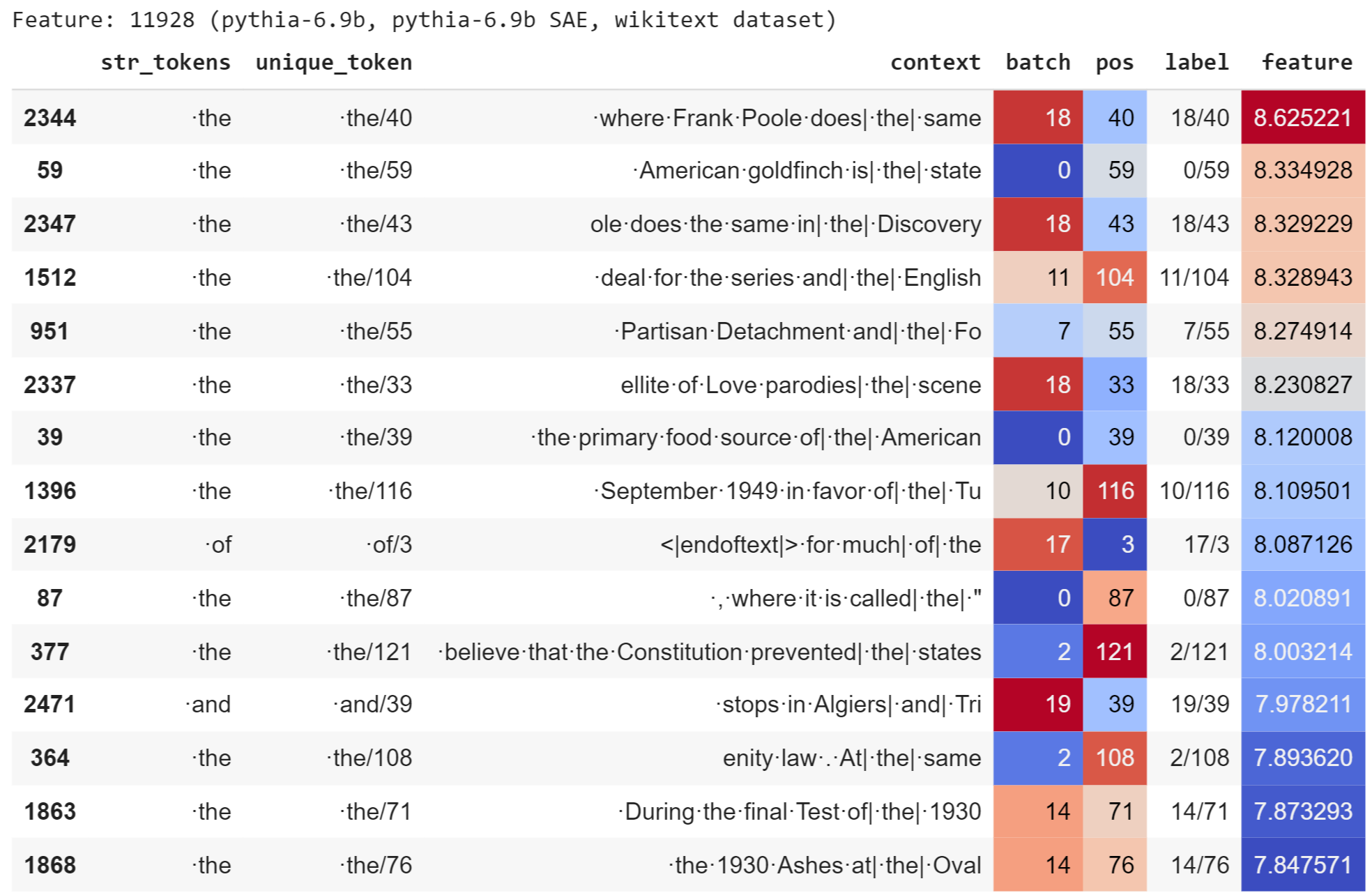
In addition, we found a surprising correlation between dead features. In particular, almost all dead features point in similar directions, as indicated by a high cosine similarity. In comparison, features that are not dead have a cosine similarity that is much closer to centered at zero. If dead features were drawn from the same distribution as non-dead features, we would expect cosine similarities closer to zero.

Fine-Tuning with a Sparse Autoencoder
We fine-tune Pythia 70M on arithmetic data by adjusting only a coefficient and bias vector within the sparse autoencoder space.
On layer $4$, we observe an unexpected lowering of loss from $6.449$ for the base model to $6.270$ after inserting the sparse autoencoder. Once fine-tuning the sparse autoencoder on arithmetic, loss remains constant at $6.270$. We believe that the fine-tuning may perform better when we experiment on a larger model such as Pythia 6.9B.
Although the loss does not fall, several features that our interpretable fine-tuning adjusts are interpretable. For example, the feature that is scaled up the most activates on colons (feature index $1338$). Because colons appear twice in every line of the arithmetic data, it makes sense that the fine-tuned model would like to more readibly predict colons. The figure below shows the top activations of feature $1338$ on the arithmetic dataset before and after fine-tuning. After fine-tuning, the feature activates slightly more strongly in all cases.
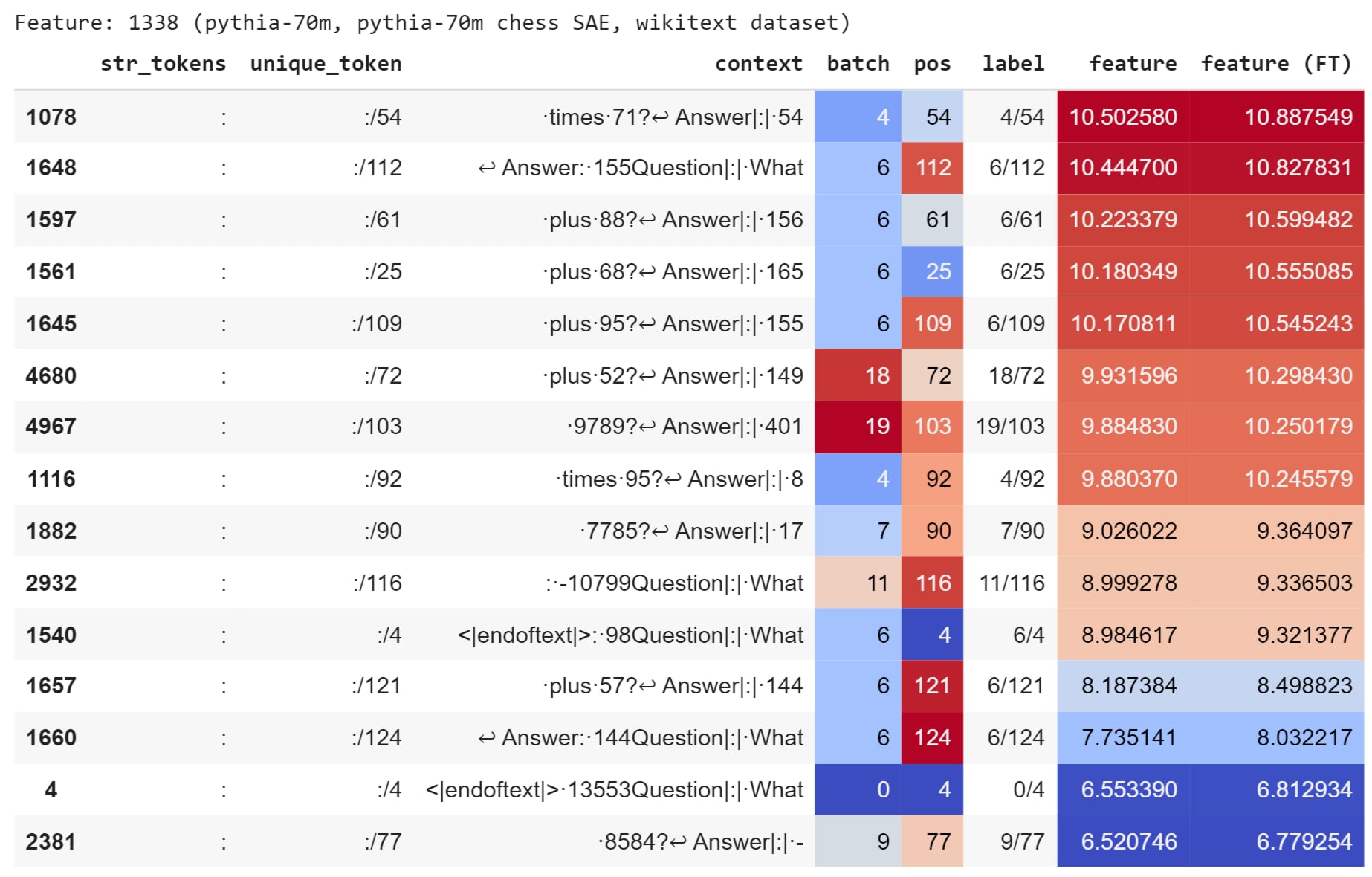
The feature that is most inhibited (feature index $619$) activates on newlines. We hypothesize that the sparse autoencoder learns to avoid newlines because, in the chess dataset for which it was trained, newlines are always followed by “Score: ”, indicating the start of a new game. But in the arithmetic dataset, newlines are always followed by “Answer: ”. Therefore, the model wants to inhibit this unhelpful feature. The discrepancy is a difference in datasets. To rigorously verify this hypothesis, we could compute direct logit attributions from feature $619$ to check whether it contributes to the “Answer” token. Either way, the inhibition above demonstrates that our fine-tuning procedure can detect and modify unhelpful features in the sparse autoencoder.
For a broader view of the dynamics of our interpretable fine-tuning, the two figures below show the learned scale and bias terms across every feature in the sparse autoencoder space (where $d_\text{auto} = 2048$), sorted in ascending order. We observe that the majority of features are largely unaffected, but a few features at the tails are significantly enhanced or inhibited.
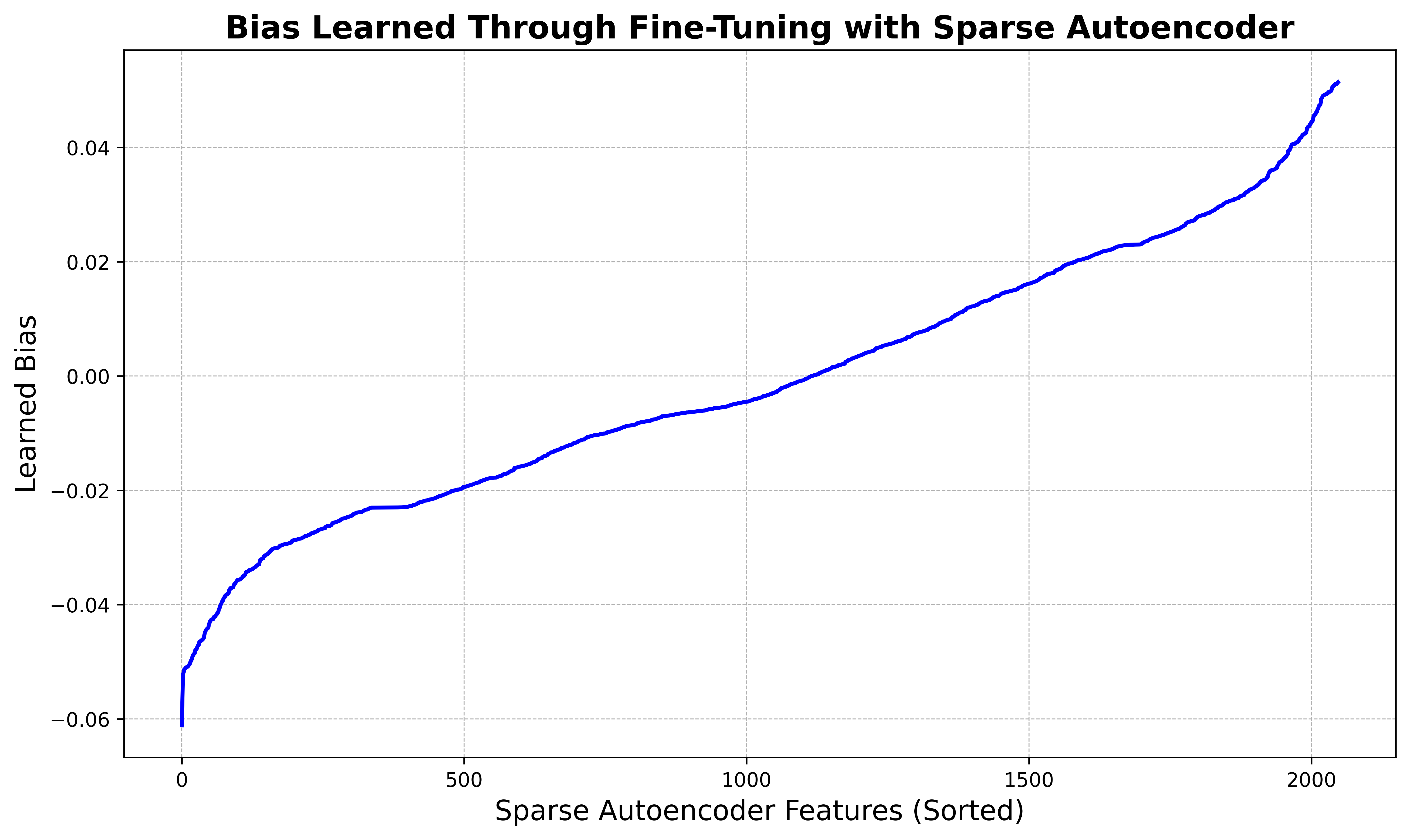
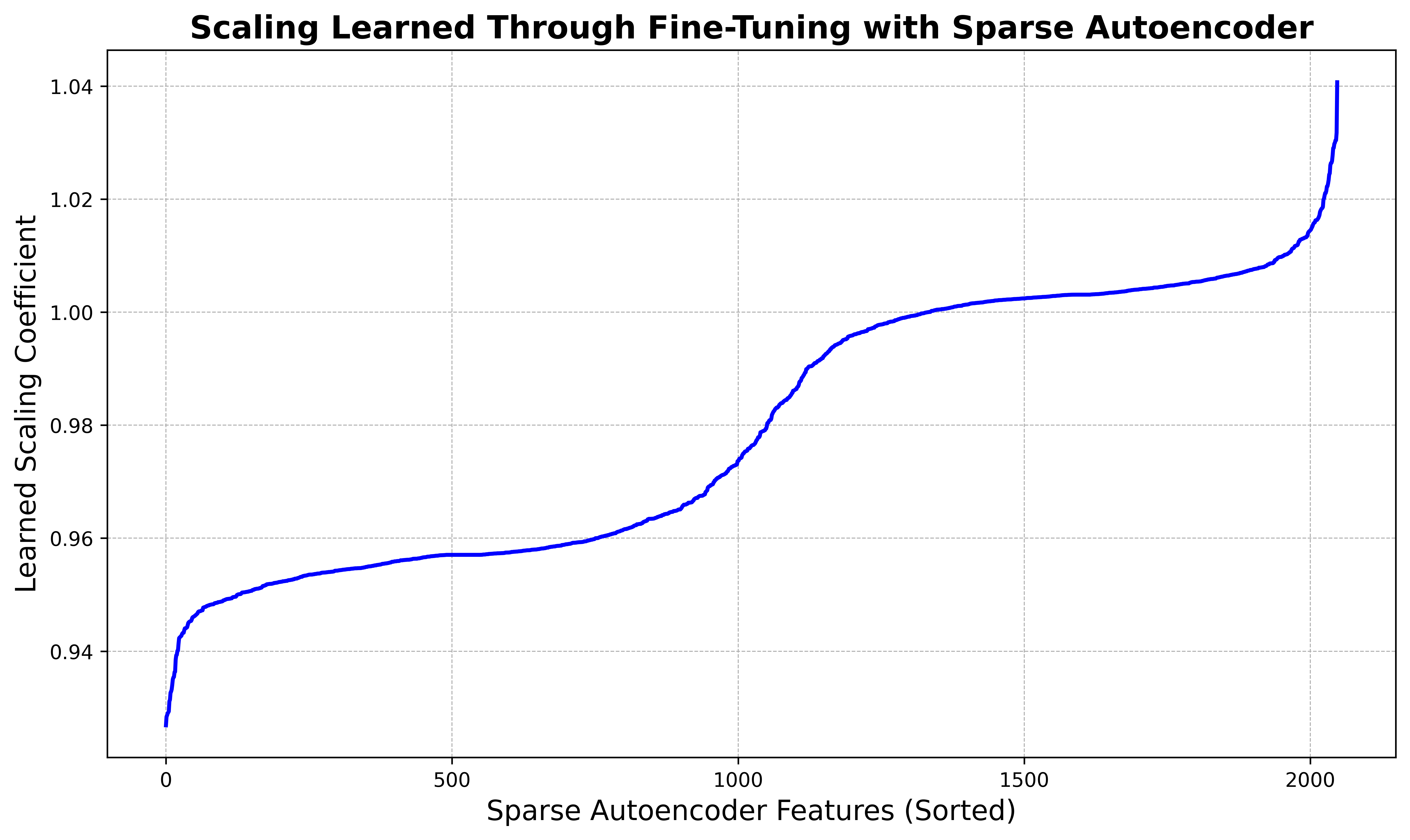
Discussion
One limitation of our fine-tuning experiments is that Pythia 70M is a small model for which there are fewer interpretable features. In addition, we inserted into Pythia 70M a sparse autoencoder trained to reconstruct activations in Pythia 70M Chess. Nonetheless, our fine-tuning results are promising. The majority of features are not significantly affected, but a few features at the tails are either significantly enhanced or inhibited. We found it fruitful to interpret these outlier features first, as they are a starting point for finding which sparse autoencoder features matter most for the fine-tuning dataset.
When training a sparse autoencoder on Pythia 6.9B, we were successful in learning interpretable features, such as the “the” feature. But we remain uncertain of the best way to train a sparse autoencoder, especially how to resample dead features. However, one implication of our work is that research on sparse autoencoders is accessible to a wide array of researchers. We believe a systematic study of training techniques for sparse autoencoders could benefit the field.
Conclusion
Our work indicates that sparse autoencoders are a promising tool for machine learning interpretability. By inserting sparse autoencoders into transformer language models, we investigate how a novel form of fine-tuning can provide insight into changes in model behavior after fine-tuning. We find that our fine-tuning successfully modifies interpretable features in the sparse autoencoder space. Given the rapid adoption of powerful, fine-tuned language models across industries, we believe our method for interpretable fine-tuning is an important direction to continue to explore as researchers seek to understand how fine-tuning affects model cognition. Although our current work is limited because we only fine-tune Pythia 70M, future work can scale up model size, compute resources, and the number of tokens used to train the sparse autoencoder. Additionally, future work can extend from direct fine-tuning to investigating the effects of RLHF performed with PPO (Proximal Policy Optimization).
Acknowledgements
We would like to thank Professor Isola, Professor Beery, and Dr. Bernstein for an introduction to fundamental perspectives in deep learning that will stay with us forever. Thank you to Logan Smith for invaluable early guidance on the questions we could explore related to sparse autoencoders. We are thankful for the AI Safety Student Team at Harvard (AISST) and MIT AI Alignment (MAIA) for a supportive community of fellow researchers.
Appendix
Our code is available at the following Google Colab notebooks: